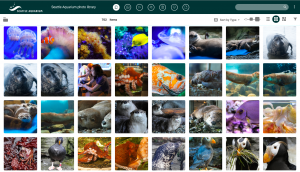3 reasons everyone is ditching cloud storage for DAM
| October 2, 2019

For many teams, there’s a tipping point when they outgrow cloud storage and need a true digital asset management (DAM) solution that centralizes their library and makes it easy to find and share assets. Here are three reasons that brands move on from cloud storage to Canto.
1. A visual, user-friendly experience
DAM is designed to be a visual platform. Users can upload any file type and preview content so that they can see what’s in their digital library at a glance. An intuitive design means that creative professionals can work within a single system that makes sense to them, whether or not they have technical experience. Canto’s focus on visual assets means that it’s designed to make storing and sharing images as easy as possible.
Cloud storage links may work well for sharing documents, but the user experience isn’t optimized for visual assets. Teams with hundreds or thousands of images benefit from using a DAM that is designed to store, organize and share visual assets, so you can see exactly what you’re working with.

“Our PR and social media agencies really love Canto! We were using Dropbox with them before, and Canto is more user-friendly,” Roqueta says. “It’s easy for them to resize or change image formats in case they need something for a certain media outlet: they can just identify the size and format they need and download it directly from Canto,” said Alessandra Roqueta, marketing manager of Boral North America’s Stone Division.
Learn more about why Boral made the switch.
2. Easy search and filter
DAM systems provide many features that help users easily find what they’re looking for. Users can search, pulling up any assets with matching keywords, tags, descriptions or file names. Canto also automatically applies “smart tags” to uploaded content and users can apply facial recognition as well to make the search process even easier.
Bumkins was using a patchy combination of servers, Dropbox, and tribal knowledge to locate and share assets. Without a DAM, it was difficult for team members to find exactly what they needed.

“The problem with cloud storage and servers is that things are hard to find and they’re not very visual. Most of the time, the team would get frustrated with searching and just come ask me because I knew where everything was,” said Leyna Segal, photo editor at Bumkins.
With Canto, the Bumkins team adds keywords and tags to their assets to make it easier for users to find what they need. In addition, Canto’s layered search and filter functionality helps users find assets quickly, creating a culture of self-service.
Learn more about how they did it.
3. Metadata and digital rights management
Most organizations use content created by a variety of sources, including third party photographers; as a result, their content will have different rights and expiration dates for usage. It’s important for companies to manage these digital rights because mistakenly using content without permission can result in expensive legal troubles.
Canto allows users to add expiration dates to content and automatically archives expired assets, taking the risk and extra work out of the equation. With cloud storage, users can’t add custom metadata fields such as usage rights. While it’s possible to work around this hurdle by sorting expired content into different folders, it’s a tedious manual task and it’s much too easy to make a mistake with large repercussions for the company.

Seattle Aquarium chose Canto because the marketing team needed a DAM to manage digital rights for their content. On their previous system consisting of a server and cloud storage, the team had no way of knowing which content they had the rights to use. Once they started using Canto, they were able to add content expiration dates and usage rights to the metadata.
Is your team ready to graduate from cloud storage to a DAM? Request a demo today!
